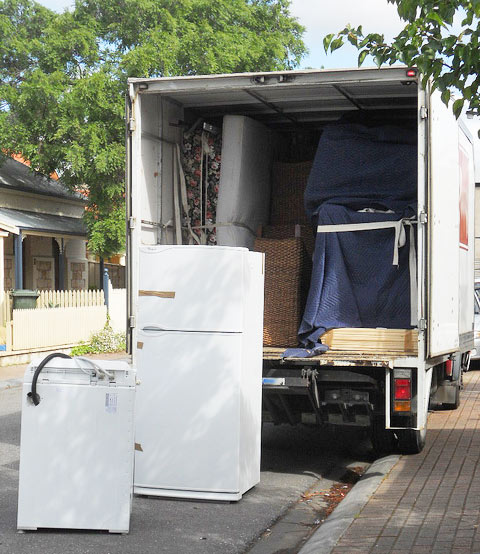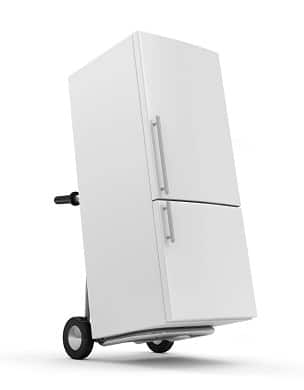Moving a fridge to another house is a difficult task – refrigerators are very heavy and quite vulnerable to damage – so people often choose not to take their cold appliances with them when moving to a new home. If your fridge is relatively new and works well, however, you may not want to leave it behind – especially if you’re moving short distance and there is no refrigerator in your future home.
If you’ve hired professional movers to help you relocate, you will have nothing to worry about – the experts will move your fridge together with the rest of your items. If you’ve decided on a DIY-move, though, you will need to find out how to move your fridge in the safest and easiest way possible.
Here are some expert tips on how to move a refrigerator by yourself that will help you complete the job with minimal effort and risk.
Prepare your fridge for moving
When moving a refrigerator by yourself, you need to take a number of preparatory steps to ensure that the appliance is ready for transportation:
- Empty the fridge several days before the move. Use up or give away the food and beverages that were stored in it;
- Turn off your refrigerator and disconnect it from the power supply;
- Defrost the fridge – Let the appliance door stay open overnight so the refrigerator defrosts completely. Make sure the water from the defrosting process is caught in suitable containers;
- Take out all detachable fridge parts – drawers, shelves, trays, etc. Clean them well, let them dry completely, and wrap them in bubble wrap to ensure their safety during the move. Pack smaller parts in cardboard boxes;
- Clean the refrigerator inside and out with a non-abrasive sponge dipped in a solution of baking soda and water. Rinse with clear water and use a soft cloth to dry the appliance. Leave the door slightly open to allow the fridge to air dry completely and to prevent mildew and bad smells from building up;
- The day before the move, close the fridge door and secure it with a piece of rope or strong cord to make sure it won’t accidentally open during the move;
- Fold up the fridge power cord, secure it with zip ties or strong rubber bands, and tape it to the back of the appliance;
- Wrap the entire refrigerator in moving blankets and stretch wrap.
Good to remember: Wrapping a fridge in protective materials is crucial for the safety of the appliance during a move:
- Thick and soft, moving blankets absorb shocks and prevent damage from impact. They also protect the fridge surface from scratches and dings;
- Plastic wrap keeps the protective padded coverings in place and prevents moisture, dust, and dirt from getting to the fridge.
Move your fridge in a safe and efficient manner
Now that your refrigerator is ready for moving, it’s time to find out how to actually take it out of your old home, load it onto the moving truck, and get it to its rightful place in your new kitchen.
Get appropriate moving equipment
Refrigerators are very heavy (older models can weigh up to 250 lbs. while newer ones are usually around 170 lbs.), so it’s not a good idea to carry your fridge by hand – even when working with a helper (you cannot possibly lift and carry such a heavy appliance on your own), you can easily drop the weighty piece and damage it, cause damage to your property, and/or get hurt. You need to use appropriate equipment that will allow you to move the appliance without too much effort and without any risk of injuries and damages.
The best way to move a refrigerator is to load it on an appliance dolly and wheel it to the moving truck (and then wheel it from the truck to its place in the new kitchen upon arrival at your new home).
So, make sure you get a refrigerator dolly with rubber wheels (to better protect the floors) for the actual transportation of your fridge.
Plan the route out of your home
The surest way to avoid accidents and problems when taking your fridge out of your home and into the moving truck is to plan in advance:
- Consider the layout of your home (stairs, tight spaces, etc.) and decide on the shortest and safest route to take your fridge from its current location to the moving vehicle;
- Measure your fridge, then measure the width and height of the doors and hallways along the route to make sure the bulky appliance will fit through. If necessary, change the route or remove some doors from their hinges to get more space;
- Clear the way of obstacles – remove any furniture, boxes, or other items from the pathways, remove low-hanging wall décor along the route, remove leaves and debris from outside walkways, etc.
Load the refrigerator on the dolly and wheel it to the moving truck
Having prepared the fridge, the dolly, and the route to the moving truck, you can finally take the appliance out of your home and to the waiting vehicle.
Here is how to move a refrigerator with a dolly:
- Tip the fridge slightly and slide the bottom plate of the appliance dolly underneath it;
- Make sure the fridge is stable and well balanced on the dolly and secure it in place with a rope or ratchet strap;
- Tilt the dolly back on its wheels and start pulling it in the desired direction;
- Wheel the fridge out of your home – Walk slowly and carefully and keep the dolly tilted backward at such an angle that the weight of the fridge remains evenly distributed over the wheels at all times.
Good to remember: If possible, avoid going down stairs when taking your fridge out of the home. If not, go down the stairs one step at a time – stay above the dolly, keeping it tilted toward you, and be sure to ease both wheels over the edge of each step and down onto the next simultaneously.
Avoid tilting the dolly too far backwards – if there is too much of a tilt, the wheels may pass over the next step, creating sudden momentum that can cause the fridge to fall off or make you lose your hold on the dolly.
Have a helper on the other side of the dolly to steady the fridge and help guide it downward. Be very careful not to drop the dolly, though – your partner may not be able to get out of the way in time.
Load the fridge into the moving truck
When you reach the waiting moving vehicle, pull the loaded dolly up the ramp. Have your helper support the fridge from below and push it forward – again, be very careful not to drop the dolly.
Take the fridge to the front of the truck (near the cabin), get it off the dolly, and secure it to the wall with ropes or straps.Good to remember: Be sure to keep the fridge in an upright position during the move – do not lay it down on its side in the moving truck and do not tilt at an angle greater than 45 degrees while taking it to and from the moving vehicle as that may damage the cooling mechanism of the fridge.
When you reach your destination, use the above tips for moving a refrigerator in reserve order to unload your fridge and take it into your new home.
Once your fridge is positioned in its place inside your new kitchen, wait at least 3 hours before plugging it in and turning it on.
Moving a fridge by yourself is a difficult and risky job – it can easily result in damage to the appliance, property damage, or personal injuries. To avoid such unfortunate scenarios, consider leaving the job to the pros – professional movers have the technical know-how, rich experience, and specialized equipment to move your fridge (and all your other appliances, furniture, and household items) in a safe and efficient manner, guaranteeing your smooth and successful relocation experience.










